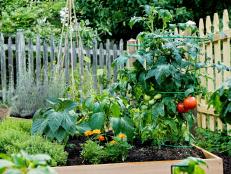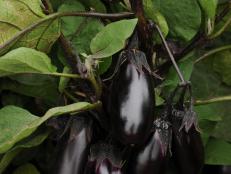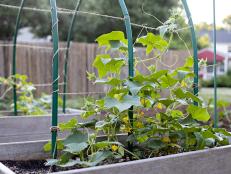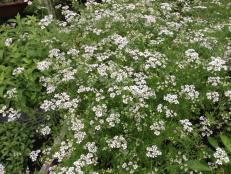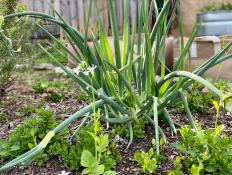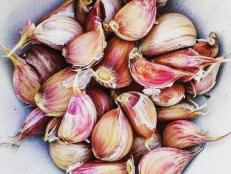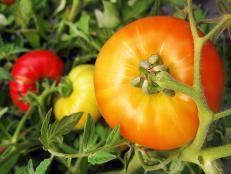Companion Planting for Okra
Boost your okra harvest by planting with companion plants, plus learn about creative ways to use okra in the garden.

Every vegetable garden should have at least one okra plant, especially warm-summered southern gardens. Okra is the statement plant of the vegetable patch, bringing creamy, hibiscus-like flowers, bold, tropical foliage, impressive stature, and attractive (and sometimes colorful) pods. Plus, the fruit are tasty pickled, fried, in soups, and especially freshly picked from the plant.
Okra is a prolific grower, producing a constant stream of delicious, flavorful seed pods throughout the warm summer months. Gardeners have their choice of many types of okra, including compact plants, colorful leaf venation, red to silver-colored pods, mini to extra-long fruits, and even spineless varieties for painless picking. These beautiful plants are also tough, and will grow happily when given the right conditions. Experiment with the plant combinations below to make the most of your okra this season.

Debbie Wolfe
What is Companion Planting?
Vegetable gardening has traditionally been all about regimented rows with bare soil or mulch between a handful of types of crops. Companion planting pairs complementary veggies, herbs, and flowering plants that will fill niches, maximize crop growth, and feed the garden ecosystem. The result of companion planting can be a vibrant garden with aesthetically pleasing layers of planting that cover bare soil and allows for plenty of sunlight and air circulation, healthy soil rich in beneficial organisms, buzzing air full of pollinators and predators of pests, and healthy and bountiful crops.
The beauty of this practice is that researchers are learning more about the intricate relationships between plants all of the time. The okra companions recommended in this article are based on current, peer reviewed scientific studies from around the world. Experiment with these pairings or use this information as a jumping off point to test new companions of your own in your garden this season.
Okra Companions
- Companion plant okra with cowpeas to attract beneficial insects, including pollinators and predators. To maximize visits from pollinators, plant cowpeas two or three weeks after okra so that both crops will be in bloom at the same time.
- Interplant with beans to mask okra from pests that rely on vision to locate crops. Whiteflies find okra and other veggies by contrasting green foliage against dark soil. Underplanting with beans makes it harder for these pesky pests to locate okra plants to feed on.
- Grow okra with fragrant herbs like basil or cilantro (coriander) to discourage pests. When these herbs bloom, their flowers may attract beneficial insects like pollinators and predators.
- Underplant a living mulch of cucumber vines below established okra plants. Cucumber foliage will shade out competing weeds, and the plants have allelopathic properties that inhibit the growth of undesired plants too. If you use this combination, plan on transplanting other crops in the area rather than direct sowing.
- Experiment with a living mulch of white clover around okra to suppress weed competition and to add nitrogen and organic matter to the soil. White clover can compete with okra plants and limit growth. For best results, overwinter a cover crop of white clover, transplant okra seedlings into the cover crop in the spring, and try to limit competition while seedlings get established.
- Grow okra after a crop of cruciferous crops (like cauliflower or cabbage) to reduce root-knot nematode populations in the soil. After harvesting the cauliflower or cabbage head, incorporate the rest of the living plant residue into the soil.
- In tropical regions, grow okra after a cover crop of sunn hemp (Crotalaria juncea) to suppress root-knot nematodes, increase nutrient availability, and boost yields.
- Okra can make a good companion to other common veggies too. Tall, sturdy okra plants lend themselves as a living trellis for vining crops with relatively small fruits like pickling cucumbers, mini pumpkins, or climbing beans (like pole or runner beans). Give okra a head start by waiting to plant companions from seed once the okra is more than a foot tall. In her book Plant Partners: Science-Based Companion Planting Strategies for the Vegetable Garden, Jessica Walliser recommends pairing okra with small-fruiting currant tomatoes such as ‘Matt’s Wild Cherry,’ ‘Hawaiian Currant,’ and ‘Sweet Pea’.
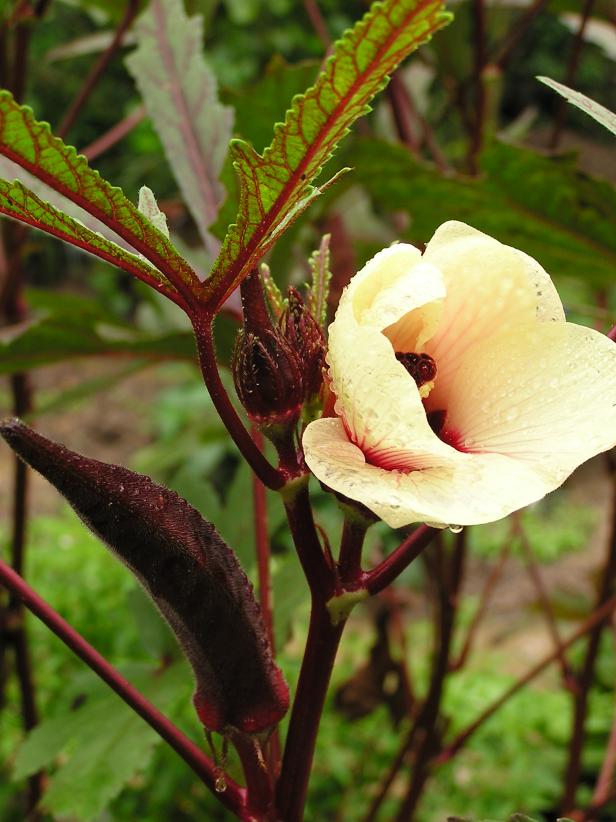
Photo by Felder Rushing
Red, orange, and burgundy varieties of okra make a stunning addition to the garden palette.
Tips for Growing Okra
Heat-loving okra is a quintessential southern crop, but many varieties can be grown successfully in northern gardens. Gardeners in northern regions should look for short-statured varieties that will take less time to flower and fruit.
To get a head start, plant okra indoors in the spring and transplant out once temperatures rise. Seedlings will need plenty of light and heat to be happy, and it may be worthwhile to invest in a grow light and heat mat. Transplant seedlings when the danger of frost is well past. Although it’s tempting to plant when days are warm, okra resents chilly nighttime temperatures. For best results, plant out when evening temperatures are above 60 degrees Fahrenheit.
Site okra in full sun (at least 6 hours a day) with well-drained soil that is rich in organic matter. Amend the bed with compost or manure before planting to improve soil quality. Avoid adding too much nitrogen fertilizer, as over-fertilized okra plants may put more effort into growing foliage rather than flowering and fruiting.
It is tempting to grow okra fairly close together, especially when sowing seeds or planting out little seedlings. Remember that many varieties get fairly large, so thin seedlings to give okra plenty of room to grow. Check the seed packet or plant label for the spacing requirements for the variety grown; okra typically needs around 3 feet of spacing. The remaining plants will be more productive and have fewer pests with ample air circulation and lots of sunshine.
Harvest okra when pods are tender and young. Many varieties are best when fruits are between 2 and 4 inches long, but some types like ‘Cowhorn’ stay tender at 10 inches. Pods grow very quickly, so plan on harvesting with a sharp knife or pruners every day or two to catch okra before it gets hard and stringy. Remove any overripe pods to keep okra plants flowering.
Southern gardeners may notice a lag in yield during the heat of summer. Try rejuvenating established okra by cutting back to 6 to 12 inches from the ground. Within a month the new growth should become productive.
How to Pickle Okra
This tangy recipe stirs up memories of summers at grandma's house.
Tips for Crop Rotation
Okra is very susceptible to nematodes, and nematode populations may boom at the end of the season. Avoid growing squash, sweet potatoes, or solanaceous crops (like tomatoes, peppers, and eggplant) after okra (and vice versa), as they may be plagued by nematodes from the previous year.

Organic grower "Farmer D" Daron Joffe holds organic okra. Okra should not follow other crops that are highly susceptible to nematodes such as squash and sweet potatoes.







